At Dark Harbor, Maine, the legacy of the Rossiter Skiff outshines that of even its most popular fiberglass counterparts. Dark Harbor, located on the mid-coast island of Islesboro, is home to a small summer colony. The family of skiffs that evolved here has been around for decades, and summer residents and local fishermen alike continue to use these boats more than a half-century after the design’s debut. Some of the boats have become family heirlooms.
First built by Willis Rossiter toward the end of World War II, the Rossiter Skiff—originally called the Willis Skiff—was designed around the increasing availability of small and reliable outboard engines. The skiffs’ plywood construction made them relatively light and the extreme rocker built into the bow allowed the boats to run up a beach for some distance before grounding out. Island picnic-goers prize the boats, as their shallow forward sections allow passengers to alight with dry feet while, on a beach of average slope, engines can remain in the water with ample depth for safe operation. Additionally, the hulls are more efficiently driven than similar-sized V-bottomed designs. The hard-chined hull is easily built and provides enough stability to accommodate whole families.
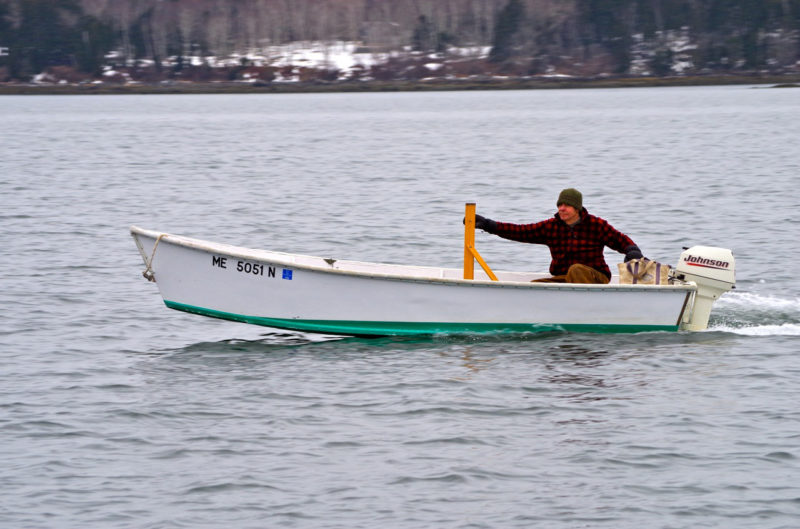 all photographs by the author
all photographs by the authorThe generous rocker forward will set the bow high on the beach for stepping ashore dry-shod.
The extreme rocker in the bow has an additional benefit: Combined with the boat’s considerable length, it allows these skiffs to be towed rather well at moderate speeds. Instead of ploughing down into the water, as some tenders do, the stem of a Rossiter Skiff lifts clear without the stern squatting; the hull simply planes along nicely.
The Rossiter Skiff has evolved over the years. Willis, after building as many as eight each winter for the better part of 20 years, built his last skiff in the early 1970s. At that time, two basic models were available: a 14-footer and a 16-footer. The 14-footer had the option of a standard or narrow beam, while the 16′ boats were all built with a beam of 5′8″. Since then, a number of builders have created their own renditions of this legendary skiff. One of the more prolific ones was island carpenter Butch McCorrison who expanded the list of offerings to include hulls as short as 9′.
More recently, Pendleton Yacht Yard (PYY), also of Islesboro, has been building Rossiter Skiffs to order. They’ve continually tweaked the design, and today’s hull is a little wider than the original version—largely to accommodate the weight of modern four-stroke engines. Also, the majority of recent builds have been the 16′ version, as this hull is large enough to tow youngsters in a tube or take the whole family on picnic outings.
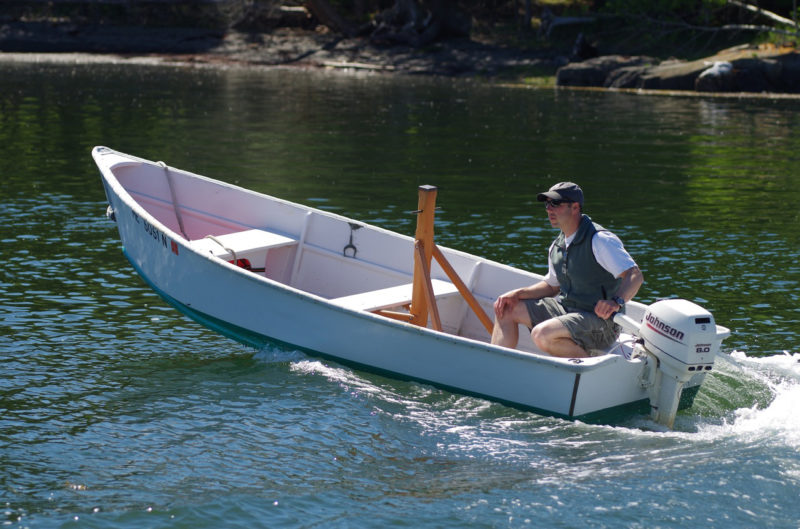
With its bit set well forward, the skiff maintains much of its maneuverability when towing.
The design is based upon economy of construction, for it takes only four sheets of plywood to build a 16′ hull. Options were and are few. The stem, frames, stringers, keel, and other structural pieces are of white oak, while thwarts have, by habit, been of mahogany. Likewise, hulls have traditionally been built of Douglas-fir marine plywood, though other good plywood options exist. Various species of mahogany plywood might take a finish better than the tried-and-true fir, but island residents—including the crew at PYY—are still partial to fir’s golden glow. Also, as PYY’s project manager Marc Clayton explains, the outer veneer of fir plywood is thicker than that of many of the other options, and this allows for the inevitable wear of frequent beaching.
The sides are of 3/8″ plywood and the bottom of 1/2″. In a nod to economy, the pieces cut away from the bottom panel at the bow are glued to the stern in order to gain the needed width, which is greater than the standard 48″ plywood sheet. Likewise, both sides of the hull are less than 24″ tall, allowing for mirror-image panels to be cut from single sheets. For the sides, a 16′ hull uses two sheets of plywood glued together and essentially ripped in half. Other offcuts from the hull are used to make the partial bulkheads under the thwarts.
PYY builds their hulls around a simple jig, and once the stem and transom are in place and the side panels fastened to them, the boat has a substantial degree of structural integrity. An oak rubrail wraps around the sheer and conceals the top end-grain of the hull’s plywood. This rail is let into both the breasthook and quarter knees. On a completed hull, this rail is largely hidden by gunwale guard.
An oak stringer running the length of the hull at the height of the thwarts provides stiffness. The thwarts are supported by partial bulkheads and significantly strengthen the hulls. Sawn frames run from the bottom stringer to the tops of the hulls. The use of the sawn frames has diminished over time; original hulls had as many as five per side while newer hulls have only one set between the aft thwart and the stern.
While transoms have typically been of solid mahogany, PYY now uses two pieces of 3/4″ plywood glued together for a beefy 1½″ of thickness. Substantial oak stringers run the length of the bottom and provide protection during beaching as well as directional stability when under way or under tow.
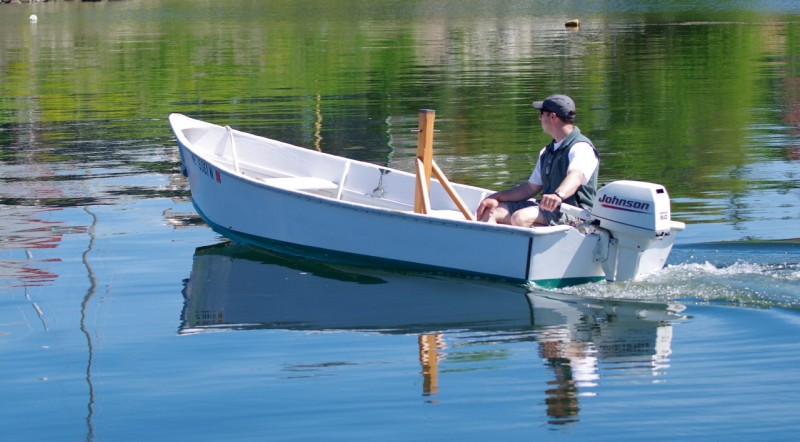
The towing bit prevents the center thwart of this skiff from being used for rowing but a set of rowlocks forward is well suited or rowing with cargo or passengers in the stern.
The Rossiter Skiff is a jack-of-all-trades, and as a result, perhaps not a master of any. However, the skiffs are rowable, extremely stable, and easily powered. They do have some downsides: They can pound in a chop and are heavy to move back to the water if left high and dry on the beach. And, being flat-bottomed, they have no bilge in which to conceal small amounts of water. However, deluxe versions have teak gratings in their after portions to keep any nuisance water well away from the operator’s feet.
Under power, with only the operator aboard, a 14-footer’s narrow hull will comfortably cruise at 14 knots with an 8-hp outboard motor. Typically, the 14′ boats use around 10 hp and 16-footers use between 15 hp and 20 hp. The 16′ hulls can easily achieve between 18 and 20 knots with two adults. While under tow a 16-footer is more stable than a 14; even a 14 will tow safely at 15 knots.
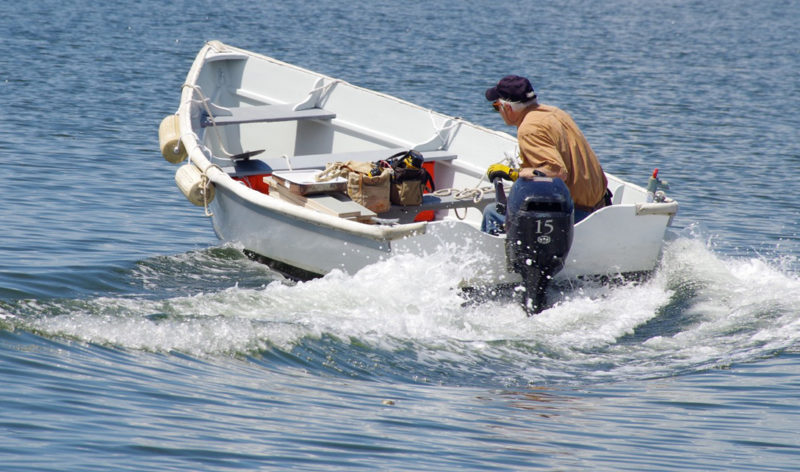
A canvas gunwale guard protects the boats tended to by this Rossiter skiff. A set of fenders hung over the rail from the thwart knees provides additional cushioning.
In addition to towing well, the Rossiter Skiff itself makes a great towboat. At PYY, these skiffs are used when hauling and launching engineless craft. Many summer families use their skiffs as tenders to their Dark Harbor 20 racing sailboats, and it is a common sight to see a “20” under tow behind a Rossiter on a windless race day. As the boats are so often used as tenders, canvas gunwale guard is standard on almost all of them, as it has been since Willis built his first skiffs. A couple of skiffs have even been fit with purpose-built towing bitts, allowing great maneuverability when towing heavy craft. The towing bitts have an added benefit: They can be used as the vertical support for a variety of canvas covers.
There is sufficient stability for an adult to easily stand on the rail of a skiff, which inspires much confidence. Although they are prone to the aforementioned pounding and chattering, in a seaway they feel secure and stable.
Islander Linda Sienkiewicz has fond memories of her father hand-hauling lobster traps and taking the family on picnics in their 16′ Rossiter Skiff. She recalls it was one of the first of many boats her family owned, and she clearly remembers it with affection. In fact, almost all islanders have at least one story to tell involving a Rossiter Skiff. These fond memories inspire a certain loyalty, and that, no doubt, is what made this design endure and thrive.![]()
Nakomis Nelson is a sailor, freelance author, and father. His armchair ambitions include sustainable architecture and organic farming. He is an avid backcountry skier and constant seeker of the unspoiled world. Nakomis and his wife run a charter yacht company in Midcoast Maine aboard their 58′ wooden motor yacht and live at the dead end of dirt road on an island off Maine’s coast.
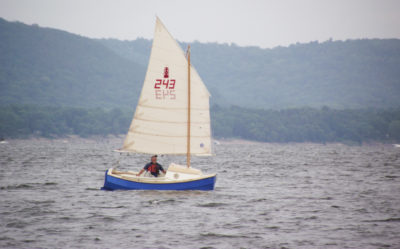
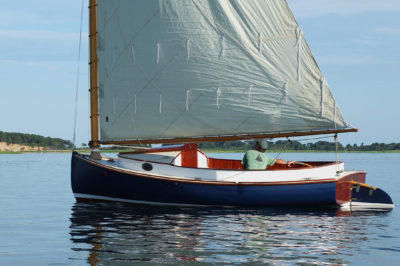
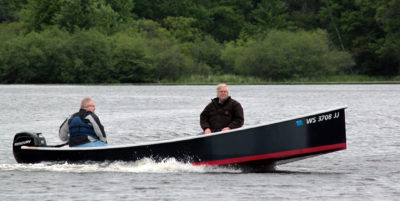
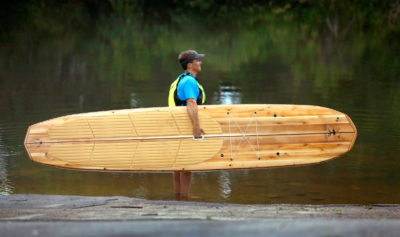
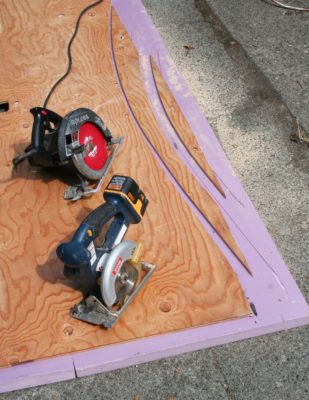
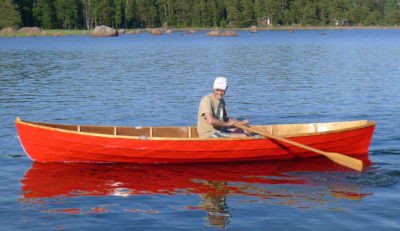
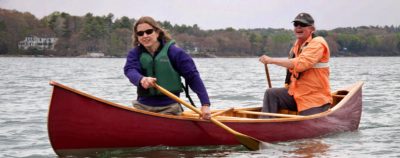

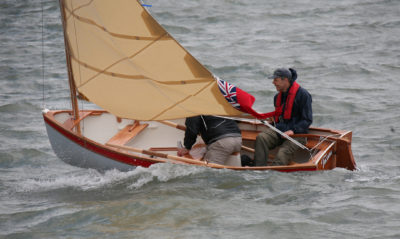
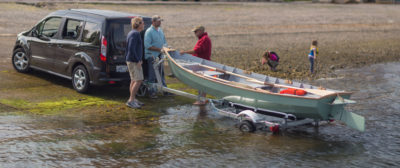
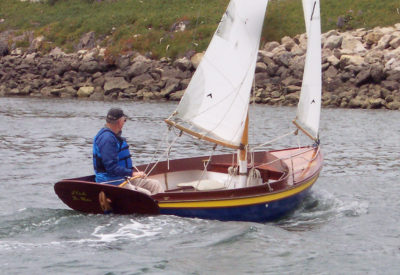
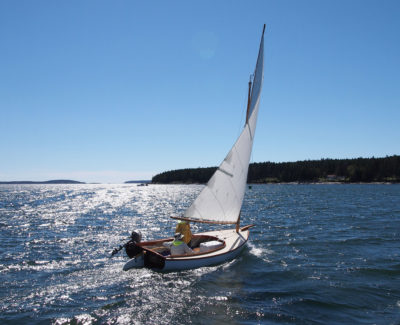
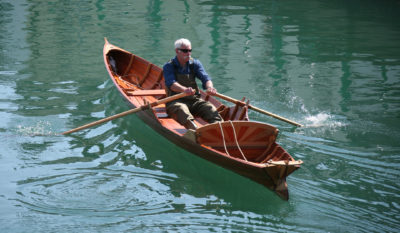
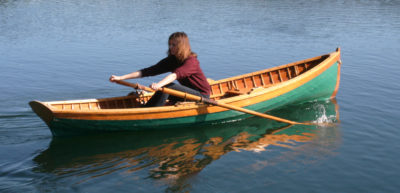
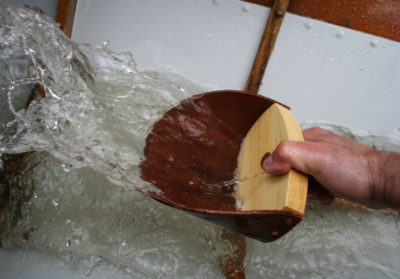
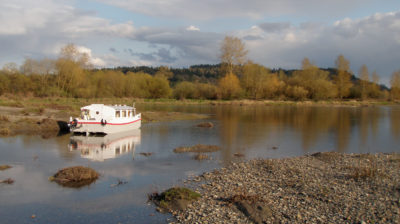
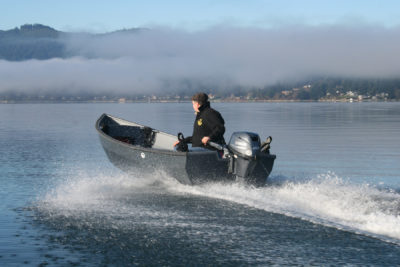
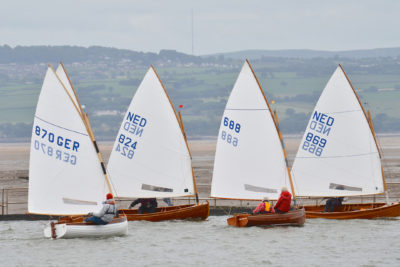
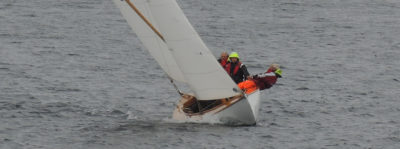
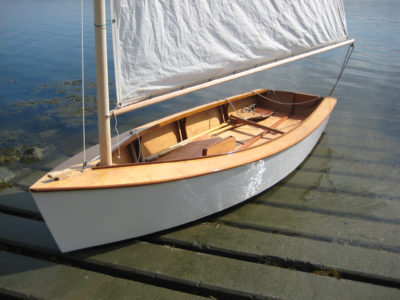
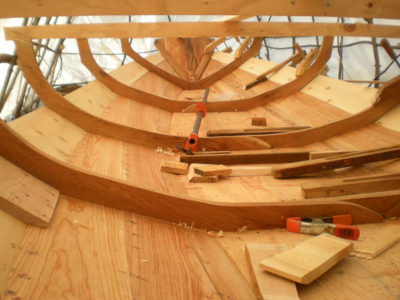
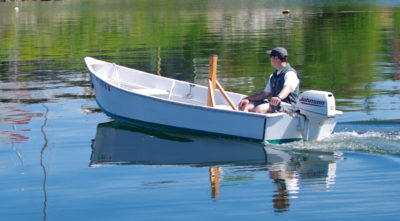
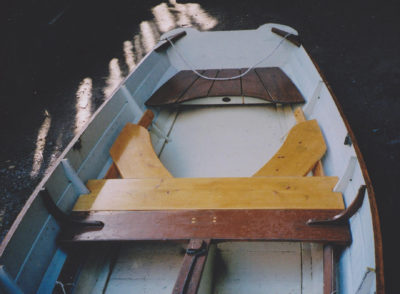
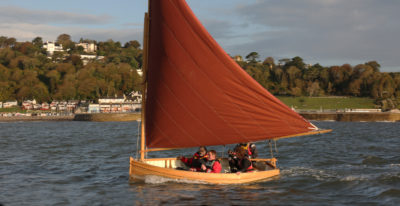
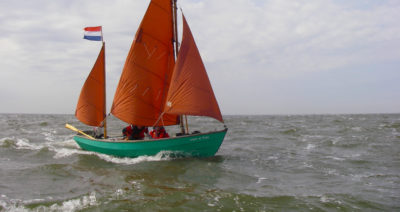
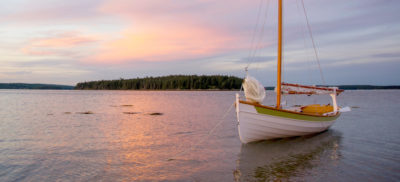
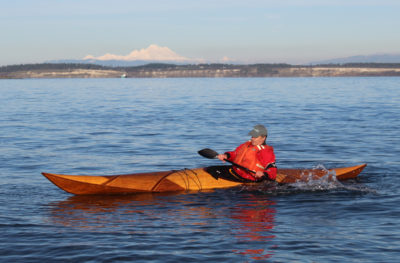
A very nice design. Those interested in the Rossiter might also want to consider the Bolger/Payson Diablo. The Diablo shares the clean simplicity of the Rossiter. Its an easy boat to build from plywood panels and has a very versatile hull shape. Plans are available for 15- and 18 -ft versions.